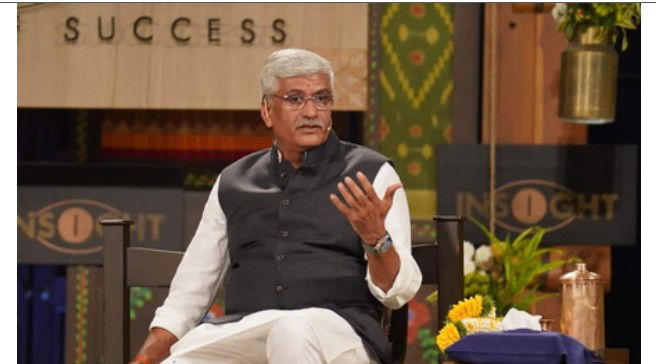Business
India’s travel economy hits Rs 2.3 lakh crore, and it’s just the beginning: Gajendra Singh Shekhawat

Jaipur, Oct 14
Tourism in India is fast emerging as one of the country’s most dynamic economic engines, scripting new success stories. With Rs 2.3 lakh crore in foreign exchange earnings in 2023 and a jump to 8th place in global tourism rankings, India is turning its temples, towns, festivals, and landscapes into serious revenue generators.
Backed by mega-events like Maha Kumbh 2025, digital tie-ups with global platforms like Netflix, and a strategic domestic push through campaigns like 'Dekho Apna Desh', the country is laying out an ambitious roadmap to make tourism a top-tier contributor to its GDP.
“India isn’t just showcasing heritage anymore -- we’re building a world-class tourism economy,” said Union Tourism Minister Gajendra Singh Shekhawat in an exclusive conversation with IANS.
From infrastructure upgrades to brand partnerships and heritage revival, the plan, he said, is to place India among the world’s top four tourism economies within the next decade.
Excerpts from the interview:
IANS: Countries like the US, France, Spain, and Italy earn significantly from tourism. Is India also aiming to position tourism as a major revenue-generating sector?
Gajendra Singh Shekhawat: Absolutely. India sees tourism as a key economic driver. We recorded 9.52 million foreign arrivals in 2023, earning over Rs 2.3 lakh crore in foreign exchange. The focus now is on scaling this through strong infrastructure and better visitor experiences. Under Swadesh Darshan 2.0 and PRASHAD, we’re developing themed circuits and modern facilities at spiritual and cultural sites. The government recently approved 40 new projects worth Rs 3,295 crore to develop lesser-known destinations under the SASCI scheme. So yes -- the direction is clear: tourism isn’t just about showcasing India; it’s about jobs, investment, and local development.
IANS: After the grand Maha Kumbh 2025, are there any other major events planned to showcase India’s cultural heritage?
Gajendra Singh Shekhawat: Mahakumbh 2025 was historic -- with over 660 million visitors -- a once-in-144-years event that truly celebrated India’s spiritual depth. But the cultural calendar stays vibrant. Later this year, we have Odisha’s Bali Yatra (November 5-12), celebrating India’s maritime heritage; the Hornbill Festival in Nagaland (December 1-10), showcasing the Northeast’s tribal richness; and the Kochi-Muziris Biennale (December 2025-March 2026), Asia’s largest contemporary art show. These events keep India’s cultural diversity alive and attract travellers from across the world.
IANS: On the Ministry of Tourism (MoT) and Netflix collaboration, how will the partnership help promote Indian destinations?
Gajendra Singh Shekhawat: Films and series are great travel ambassadors. Through our tie-up with Netflix, we’re opening up Indian locations to global audiences -- from heritage cities to remote landscapes. The Ministry will help identify filming spots, simplify permissions, and support logistics. The idea is simple: when viewers fall in love with a place on screen, they often want to see it for themselves. Shows like 'The Elephant Whisperers', 'Kaala Paani', or 'Amar Singh Chamkila' have shown how storytelling can drive tourism. This collaboration takes that power to the next level.
IANS: India’s domestic tourism is booming. How is the Ministry planning to take it further?
Gajendra Singh Shekhawat: Domestic tourism is our backbone. The “Dekho Apna Desh” campaign is urging Indians to explore their own country. We’re improving connectivity, infrastructure, and amenities through Swadesh Darshan 2.0 and upgrading the top 50 tourist destinations in partnership with states. We’re also backing homestays through Mudra loans, investing in guide training, and recently cut GST on hotel tariffs to make travel more affordable. It’s about creating memorable, affordable, and accessible experiences for every Indian traveller.
IANS: India has moved up to 8th place in WTTC’s global tourism rankings. What’s the next goal?
Gajendra Singh Shekhawat: We’re aiming high -- the goal is to be among the top four tourism economies globally within the next decade. The roadmap is clear: better connectivity, cleaner destinations, strong branding, and seamless visitor experiences. Partnerships like Netflix help globally; schemes like Swadesh Darshan 2.0 strengthen the ground reality. We want India to be a 365-day destination where culture, wellness, nature, and adventure come together.
IANS: Is tourism in Rajasthan a missed opportunity? Rajasthan has incredible tourism assets, but still attracts fewer foreign tourists than expected. Why, and what’s being done?
Gajendra Singh Shekhawat: Rajasthan is a jewel, but yes, foreign arrivals are below potential. Limited direct flights, high travel costs, and uneven promotion are key reasons. We’re working with the state to fix that -- more international connectivity, better amenities, and focused overseas marketing. There’s also a push to revive Shekhawati’s havelis into heritage hotels. Once infrastructure and storytelling improve, Rajasthan’s global numbers will reflect its true potential.
IANS: On global comparison -- the US earns the most from tourism, while France leads in arrivals. What can India learn from them?
Gajendra Singh Shekhawat: Three things. First, world-class infrastructure -- from airports to roads to digital access. Second, strong branding like France’s Atout France, which markets seamlessly across the world. And third, diversified experiences -- culture, gastronomy, business, nature, wellness -- all professionally managed. India already has the raw material; we’re now building the polish to match the world’s best.







































